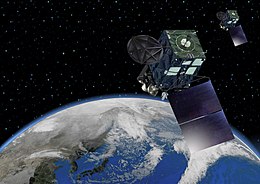 Rendering of Himawari 8 and 9 | |
| Mission type | Weather satellite |
|---|---|
| Operator | JMA |
| COSPAR ID | 2014-060A |
| SATCAT no. | 40267 |
| Mission duration | 8 years (planned) |
| Spacecraft properties | |
| Bus | DS2000 |
| Manufacturer | Mitsubishi Electric |
| Launch mass | 3500 kg |
| Dry mass | 1300 kg |
| Power | 2.6 kilowatts from solar array |
| Start of mission | |
| Launch date | 7 October 2014, 05:16 UTC |
| Rocket | H-IIA 202 |
| Launch site | Tanegashima LA-Y1 |
| Contractor | Mitsubishi Heavy Industries |
| Entered service | 7 July 2015, 02:00 UTC[1] |
| Orbital parameters | |
| Reference system | Geocentric |
| Regime | Geostationary |
| Longitude | 140.7° East |
| Perigee altitude | 35,791 km (22,239 mi)[2] |
| Apogee altitude | 35,795 km (22,242 mi)[2] |
| Inclination | 0.03 degrees[2] |
| Period | 1436.13 minutes[2] |
| Epoch | 22 January 2015, 22:13:28 UTC[2] |
Himawari 8 (ひまわり8号) is a Japanese weather satellite, the 8th of the Himawari geostationary weather satellites operated by the Japan Meteorological Agency. The spacecraft was constructed by Mitsubishi Electric with assistance from Boeing, and is the first of two similar satellites to be based on the DS2000 satellite bus.[3] Himawari 8 entered operational service on 7 July 2015 and is the successor to MTSAT-2 (Himawari 7) which was launched in 2006.
- ^ "静止気象衛星「ひまわり8号」の運用開始日について" (in Japanese). Japan Meteorological Agency. Retrieved 27 May 2015.
- ^ a b c d e Peat, Chris (22 January 2015). "HIMAWARI 8 - Orbit". Heavens-Above. Retrieved 25 January 2015.
- ^ Graham, William (6 October 2014). "Japan lofts Himawari 8 weather satellite via H-IIA rocket". NASASpaceflight.com. Retrieved 7 October 2014.